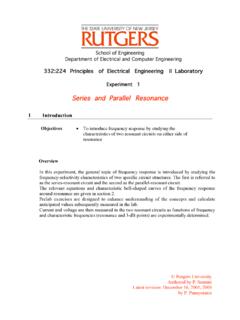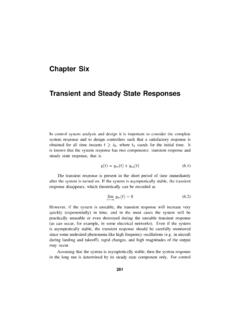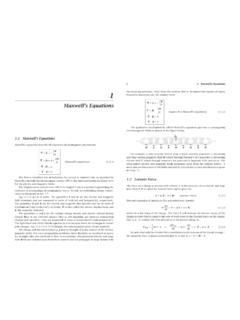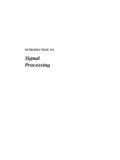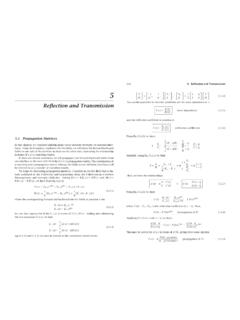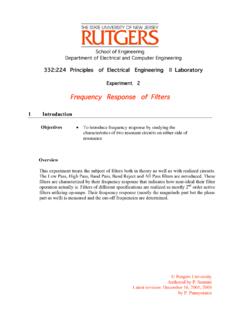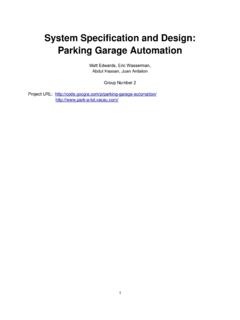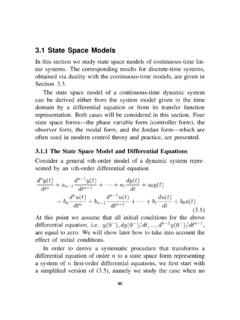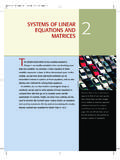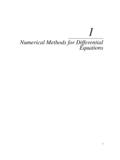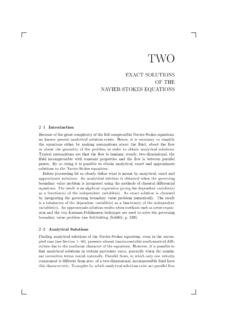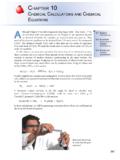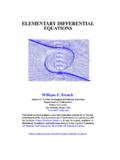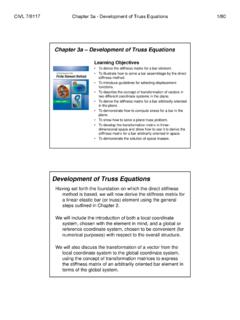Transcription of Maxwell’s Equations - Rutgers ECE
1 1 maxwell s maxwell s EquationsMaxwell s Equations describe all (classical) electromagnetic phenomena: E= B t H=J+ D t D= B=0( maxwell s Equations )( )The first isFaraday s law of induction, the second isAmp`ere s lawas amended byMaxwell to include the displacement current D/ t, the third and fourth areGauss lawsfor the electric and magnetic displacement current term D/ tin Amp`ere s law is essential in predicting theexistence of propagating electromagnetic waves. Its role in establishing charge conser-vation is discussed in Sec. ( ) are in SI units.
2 The quantitiesEandHare the electric and magneticfield intensitiesand are measured in units of [volt/m] and [ampere/m], quantitiesDandBare the electric and magneticflux densitiesand are in units of[coulomb/m2] and [weber/m2], or [tesla].Dis also called theelectric displacement, andB, themagnetic quantities andJare thevolume charge densityandelectric current density(charge flux) of anyexternalcharges (that is, not including any induced polarizationcharges and currents.) They are measured in units of [coulomb/m3] and [ampere/m2].The right-hand side of the fourth equation is zero because there are no magnetic mono-pole charges.
3 Eqs. ( ) ( ) display the induced polarization terms charge and current densities ,Jmay be thought of as thesourcesof the electro-magnetic fields. For wave propagation problems, these densities are localized in space;for example, they are restricted to flow on an antenna. The generated electric and mag-netic fields areradiatedaway from these sources and can propagate to large distances to21. maxwell s Equationsthe receiving antennas. Away from the sources, that is, in source-free regions of space, maxwell s Equations take the simpler form: E= B t H= D t D=0 B=0(source-free maxwell s Equations )( )The qualitative mechanism by which maxwell s Equations give rise to propagatingelectromagnetic fields is shown in the figure example, a time-varying currentJon a linear antenna generates a circulatingand time-varying magnetic fieldH, which through Faraday s law generates a circulatingelectric fieldE, which through Amp`ere s law generates a magnetic field, and so on.
4 Thecross-linked electric and magnetic fields propagate away from the current source. Amore precise discussion of the fields radiated by a localized current distribution is givenin Chap. Lorentz ForceThe force on a chargeqmoving with velocityvin the presence of an electric and mag-netic fieldE,Bis called the Lorentz force and is given by:F=q(E+v B)(Lorentz force)( )Newton s equation of motion is (for non-relativistic speeds):mdvdt=F=q(E+v B)( )wheremis the mass of the charge. The forceFwill increase the kinetic energy of thecharge at a rate that is equal to the rate of work done by the Lorentz force on the charge,that is,v F.
5 Indeed, the time-derivative of the kinetic energy is:Wkin=12mv v dWkindt=mv dvdt=v F=qv E( )We note that only the electric force contributes to the increase of the kinetic energy the magnetic force remains perpendicular tov, that is,v (v B)= Constitutive Relations3 Volume charge and current distributions ,Jare also subjected to forces in thepresence of fields. The Lorentz forceper unit volumeacting on ,Jis given by:f= E+J B(Lorentz force per unit volume)( )wherefis measured in units of [newton/m3]. IfJarises from the motion of chargeswithin the distribution , thenJ= v(as explained in Sec.)
6 In this case,f= (E+v B)( )By analogy with Eq. ( ), the quantityv f= v E=J Erepresents thepowerper unit volumeof the forces acting on the moving charges, that is, the power expendedby (or lost from) the fields and converted into kinetic energy of the charges, or heat. Ithas units of [watts/m3]. We will denote it by:dPlossdV=J E(ohmic power losses per unit volume)( )In Sec. , we discuss its role in the conservation of energy. We will find that elec-tromagnetic energy flowing into a region will partially increase the stored energy in thatregion and partially dissipate into heat according to Eq.
7 ( ). Constitutive RelationsThe electric and magnetic flux densitiesD,Bare related to the field intensitiesE,Hviathe so-calledconstitutive relations, whose precise form depends on the material in whichthe fields exist. Invacuum, they take their simplest form:D= 0EB= 0H( )where 0, 0are thepermittivityandpermeabilityof vacuum, with numerical values: 0= 10 12farad/m 0=4 10 7henry/m( )The units for 0and 0are the units of the ratiosD/EandB/H, that is,coulomb/m2volt/m=coulombvolt m=faradm,weber/m2ampere/m=weberampere m=henrymFrom the two quantities 0, 0, we can define two other physical constants, namely,thespeed of lightand thecharacteristic impedanceof vacuum:c0=1 0 0=3 108m/sec, 0= 0 0=377 ohm( )41.
8 maxwell s EquationsThe next simplest form of the constitutive relations is for simple homogeneousisotropic dielectric and for magnetic materials:D= EB= H( )These are typically valid at low frequencies. The permittivity and permeability are related to theelectric and magnetic susceptibilitiesof the material as follows: = 0(1+ ) = 0(1+ m)( )The susceptibilities , mare measures of the electric and magnetic polarizationproperties of the material. For example, we have for the electric flux density:D= E= 0(1+ )E= 0E+ 0 E= 0E+P( )where the quantityP= 0 Erepresents the dielectric polarization of the material, thatis, the average electric dipole moment per unit volume.
9 In a magnetic material, we haveB= 0(H+M)= 0(H+ mH)= 0(1+ m)H= H( )whereM= mHis themagnetization, that is, the average magnetic moment per unitvolume. The speed of light in the material and the characteristic impedance are:c=1 , = ( )Therelative permittivity, permeabilityandrefractive indexof a material are defined by: rel= 0=1+ , rel= 0=1+ m,n= rel rel( )so thatn2= rel rel. Using the definition of Eq. ( ), we may relate the speed of lightand impedance of the material to the corresponding vacuum values:c=1 =1 0 0 rel rel=c0 rel rel=c0n = = 0 0 rel rel= 0 rel rel= 0 reln= 0n rel( )For a non-magnetic material, we have = 0, or, rel=1, and the impedancebecomes simply = 0/n, a relationship that we will use extensively in this generally, constitutive relations may be inhomogeneous, anisotropic, nonlin-ear, frequency dependent (dispersive), or all of the above.
10 Ininhomogeneous materials,the permittivity depends on the location within the material:D(r,t)= (r)E(r,t) Constitutive Relations5 Inanisotropic materials, depends on thex,y,zdirection and the constitutive rela-tions may be written component-wise in matrix (or tensor) form: DxDyDz = xx xy xz yx yy yz zx zy zz ExEyEz ( )Anisotropy is an inherent property of the atomic/molecular structure of the dielec-tric. It may also be caused by the application of external fields. For example, conductorsand plasmas in the presence of a constant magnetic field such as the ionosphere in thepresence of the Earth s magnetic field become anisotropic (see for example, on the Hall effect.)
